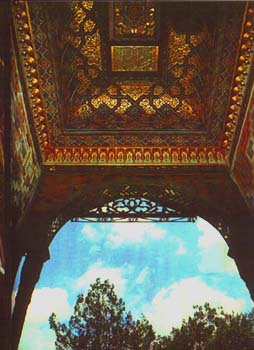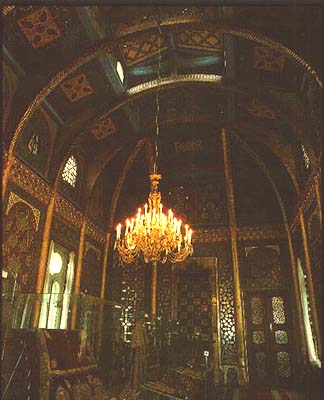The Khanate
Bukhara did not re-emerge from Samarkand's shadow until
Abdullah Khan, descended from Genghis Khan's grandson Sheiban, rebuilt
most of it in the second half of the 16th century. He also formed the Sheibanid
empire by conquering Baikh, Fergana, Tashkent, Khorasan and Khorezm.
 During
the 17th century the empire shrank back to its core between the Amu Daiya
and Syr Darya rivers and became known as the Khanate of Bukhara. Abdullah
Khan's less competent Sheibanid successors wasted their limited energies
bickering with other khanates until Nadir Shah invaded from Persia and
founded the Astrakhanid dynasty in 1740. In 1784 the merely unimaginative
Astrakhanids were replaced by the positively
backward-looking Manghits, who called themselves emirs instead of khans
and ruled till 1920. Their founder, Emir Maasum, was, according to Curzon,
'a bigoted devotee, wearing the dress and imitating the life of a dervish'.
He was also, by contemporary standards at any rate, a pervert. If the writings
of a German doctor who penetrated Bukhara in disguise in 1820 are to be
believed, the emir retained, in addition to his harem, 'forty or fifty
degraded beings', with whom he indulged in 'all the horrors and abominations
of Sodom and Gomorrah'.
During
the 17th century the empire shrank back to its core between the Amu Daiya
and Syr Darya rivers and became known as the Khanate of Bukhara. Abdullah
Khan's less competent Sheibanid successors wasted their limited energies
bickering with other khanates until Nadir Shah invaded from Persia and
founded the Astrakhanid dynasty in 1740. In 1784 the merely unimaginative
Astrakhanids were replaced by the positively
backward-looking Manghits, who called themselves emirs instead of khans
and ruled till 1920. Their founder, Emir Maasum, was, according to Curzon,
'a bigoted devotee, wearing the dress and imitating the life of a dervish'.
He was also, by contemporary standards at any rate, a pervert. If the writings
of a German doctor who penetrated Bukhara in disguise in 1820 are to be
believed, the emir retained, in addition to his harem, 'forty or fifty
degraded beings', with whom he indulged in 'all the horrors and abominations
of Sodom and Gomorrah'.
Maasum's son Nasrullah received in 1832 the audacious,
polyglot British officer Alexander Burnes, whose Travels Into Bukhara contains
the most colourful and intelligent description available of the city in
the early 19th century. Its population of 150,000 was half that of pre-Mongol
times, and three quarters of it was of slave extraction, mostly descended
from Persian slaves captured and sold at Bukhara's infamous slave market
by Turkmen nomads. There were also Russian slaves:
'A red beard, grey eyes, and fair skin, will now and then
arrest the notice of a stranger, and his attention will have been fixed
on a poor Russian, who has lost his country and his liberty, and drags
out a miserable life of slavery.'
Not everyone was oppressed. Hindus, Jews and European
merchants lived and traded unmolested in return for observing certain ground
rules. Only Muslims might ride horses within the city. Whosoever failed
to look away as the emir's harem passed risked 'a blow on the head'. Anyone
out at night without a lamp would be assumed by the emir's police to be
a burglar. And the sabbath (Friday) was strict: 'If a person is caught
flying pigeons on a Friday he is sent forth with the dead bird round his
neck, seated on a camel.'
Students were numerous-Burnes reported 366 madrasas each
with from 10 to 80 students-and privileged; each had a right to a yearly
maintenance grant from their madrasa, and to a share of the state's income.
They were not all young: Burnes found 'many of them grave and demure old
men, with more hypocrisy, but by no means less vice, than the youths in
other quarters of the world.'
Women blackened their teeth and were absolutely not to
be looked at except by their husbands, who were entitled to shoot peeping
Toms.
The city centre, finally, contained 'many ponderous and
massy buildings, colleges, mosques and lofty minarets,' while 'the common
houses are built of sun-dried bricks on a framework of wood, and are all
flat-roofed'-as they are today.
Age did not mellow Nasrullah. Ten years after Burnes'
visit he gained worldwide notoriety by throwing two less diplomatic British
officers, Colonel Stoddart and Captain Conolly, into his bug pit and then
beheading them, slighted that Queen Victoria had not pleaded in person
for their lives. It was one of the most gruesome and, thanks to an eccentric
clergyman, highly publicized episodes in the Central Asian war of nerves
between Britain and Russia which Kipling called the Great Game (see Zindan).
Bukhara had huge symbolic importance for Central Asian
Muslims and for British Russo-phobes who thought its annexation by St Petersburg
would be a prelude to a Russian invasion of India. So Russia trod carefully.
When Bukhara's clergy declared a holy war against her in 1868, General
Kaufmann had his pretext for attacking Samarkand to protect Tashkent. He
didn't meddle with Bukhara but he did take control of her water supply.
The holy war petered out, the frustrated clergy led a revolt against the
emir, and the Russians stepped in to crush it for him. Without ever attacking
the city they reduced it to vassal status in a treaty of 1873.
Colonial Bukhara
' Russian, or 'New' Bukhara was even more separate from
the old city than were the Russian cantonments at Tashkent and Samarkand.
Born when the railway came from Krasnovodsk in 1888, it was centered on
the station ten miles south of Bukhara proper at Kagan. The now disused
Russian church is still there.
 There
followed a delicate 30-year-long, four-cornered power struggle. In the
Ark and the gaudy summer palace resided the last emir, Alim Khan, hanging
onto the trappings of 'power. Outside the city strutted the Russian garrison
and political agent, wanting stability and trade and prepared to support
the emir as long as he delivered it. In the mosques and madrasas the mullahs
swore death to the infidel and cursed the emir for his dubious loyalty.
On street corners and in smoke-filled rooms angry young men whispered a
dangerous new jargon about reforms and rights and pan-Turkic brotherhood.
There
followed a delicate 30-year-long, four-cornered power struggle. In the
Ark and the gaudy summer palace resided the last emir, Alim Khan, hanging
onto the trappings of 'power. Outside the city strutted the Russian garrison
and political agent, wanting stability and trade and prepared to support
the emir as long as he delivered it. In the mosques and madrasas the mullahs
swore death to the infidel and cursed the emir for his dubious loyalty.
On street corners and in smoke-filled rooms angry young men whispered a
dangerous new jargon about reforms and rights and pan-Turkic brotherhood.
In 1910 a general massacre of Shi'ite Muslims by Sunnis
ended the city's traditional inter-denominational harmony and was blamed
on the reformers, who went underground. The Russian premier Stolypin threatened
outright annexation of Bukhara. To forestall it the emir promised
financial and educational reform but entrusted it to the clergy, who smoth-à
ered it. In the years leading up to the Russian Revolution of 1917 the
once-liberal underground, funded by a merchant millionaire called Mirza
Muhitdin Mansur-oghli, grew more frustrated and extreme. But it was not
the works of Marx and Lenin they were reading. Mansur-oghli paid for them
to go to university in Istanbul and get high on the anti-Russian, pan-Turkic
teachings of Mustapha Kemal.
The Russian Revolution
When revolutionaries took over St Petersburg and Moscow
in 1917, the Emir of Bukhara Was nearly dizzied by the political weathervane.
At first, goaded by a murky Russian agent with the un-Russian name of Miller,
who had himself switched quickly from the czarists to the communists, he
offered his own package of reforms. But when he saw that H Bukhara was
not at the top of revolutionary Moscow's agenda he withdrew it. His people
seethed. A communist among them, Khodja-oghli (Khojaev), told the Bolsheviks
in Tashkent that Bukhara's proletariat was ready to revolt. He was wrong.
When the Bolsheviks came the emir had them slaughtered at the station,
and Bukhara became unofficial centre of the Central Asian counter-revolution.
Early in 1920 the emir forbad trade with Russia or Soviet
Turkestan. It was a self-imposed blockade. By July three quarters of the
khanate's livestock was dead and its people were running out of water.
The Istanbul-trained Young Bukharans were at odds with the new and mainly
Russian Bukhara Communist Party-but a marriage of convenience looked imminent.
In August the Red Army bombarded the city and in September,
while the emir was away trying to assemble an army, it took possession.
Moscow still feared provoking an Islamic uprising, so home-grown revolutionaries
were allowed to found the Bukharan People's Republic, nominally independent
of the Soviet Union. But the BPR proved awkwardly receptive to overtures
from Istanbul, and when the Bolsheviks had a breathing space from their
European struggle, they purged Bukhara's communists. On 19 September 1924
the Bukhara Communist Party voted unanimously at its fifth congress to
abolish the BPR and found a Soviet Republic in its place.
Soviet Bukhara
As a stronghold of Muslim culture, Bukhara presented the
evangelically atheistic Bolsheviks with a tricky choice: to raze it and
start again, or to let it decay. They chose the latter. In the 20 years
following the revolution its population fell by half. Fitzroy Maclean wrote
after his visit in 1938: 'With the exception of a highly incongruous Pedagogic
Institute which has made a somewhat half-hearted appearance within its
walls, the dying city of Bukhara has remained purely Eastern. The only
changes are those which have been wrought by neglect, decay and demolition.'
The purging of anti-Soviet elements had continued steadily,
culminating in 1938 with the execution after a show trial of Bukhara's
most famous communist son, the same Khojaev who had invited the Bolsheviks
to lead an insurrection in 1918 and who subsequently became Soviet Uzbekistan's
first president.
The Soviets did Bukhara the favour of draining and filling
in most of its famous pools (there had been 100 when Burnes paid his visit).
The diseases they harboured-'Bukhara Boil', 'Sartian Sickness', Guinea
worm-disappeared, but so did most of the city's soul. An alternative water
supply arrived in 1968 in the form of the 180-km Amu-Bukharski Canal from
the river Amu-Darya. Water was suddenly ten times more abundant and President
Sharaf Rashidov took the credit while the Aral Sea took the strain.
Mean while Bukhara was industrialized. Processing plants
were built on its outskirts for cotton, silk, wool, meat and milk. The
city was honoured with the Soviet Union's biggest Karakul 'factory', in
which Karakul lambs are killed before or shortly after birth for their
tightly-curled coats which are said to be warmer and softer even than those
of Astrakhan lambs. There is also a guano factory staffed by
pigeons.
[back]
